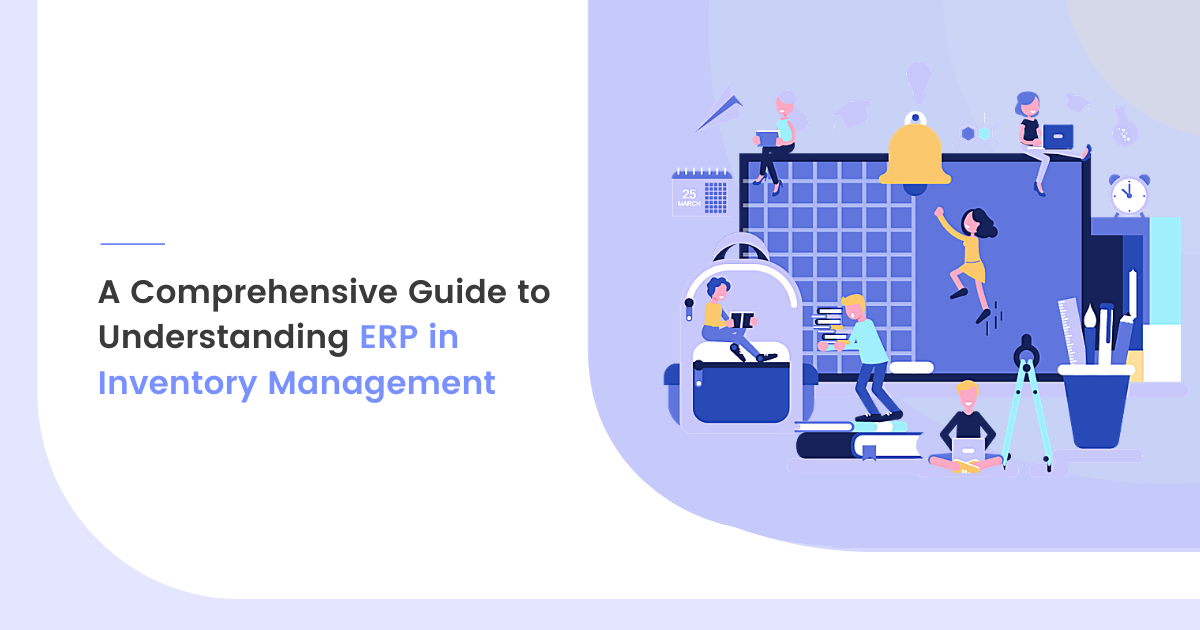The Enterprise Resource Planning tool, also referred to as stock control, handles all aspects of a company’s inventory system including purchasing, receiving, tracking, warehousing and storage, shipping, turnover, and reordering. You can easily track orders, inventory levels, sales, and deliveries in point of sale and enjoy a streamlined inventory management process.
The software is a computer-based solution that helps automate all your inventory management functions. It offers organizations a comprehensive solution for their inventory management requirements.
In this article, we will cover the following topics in-depth:
The ERP market is in a phase of rapid expansion, and the total market size is expected to surpass $49.5 billion by 2024.
ERP aims to maximize profits by involving minimum inventory investment, without disturbing customer satisfaction levels.
Let’s deep dive!
Benefits of Integrating ERP in Inventory Management
ERP is quickly securing its position in organizations. Several operations, which weren’t initially included in ERP by default, are now integrated with ERP to enjoy larger benefits. On average, companies spend over 6.5% of their annual budget on ERP.
Here’s how integrating ERP in inventory management is beneficial:
1. Inventory Optimization
Inventory challenges are many- a simple slip and things can take a bad turn.
In a dynamic market, keeping old products in inventory is suggestable. This becomes more critical for fast-moving products. Simultaneously, lack of surplus may lead to losses if there’s an increase in demand or the current stock goes bad.
Owners can be reluctant to have a large pile of surplus inventory because it binds capital which can only be through sales.
The benefit is you can optimize your inventory by integrating ERP in inventory management. The tool provides insights on the current stock and any future rise/fall in demand.

Looking for Enterprise Resource Software? Check out SoftwareSuggest’s list of Best ERP Software solutions.
2. Supply Chain visibility
A supply chain is a complicated process involving multiple parties supplying goods materials to the companies. To do this smoothly, inventory details need to be regularly updated and shared. Initially, companies had the authority to carry out this task, but failing to share updates or incorrect updates led to the wrong supply, disturbing the entire supply chain.
ERP integration can avoid such inconveniences. The entire inventory gets integrated easy-to-access tools, real-time and accurate details. You can share these details with any third-party including suppliers or logistics
3. Precise Financial reports
In most companies, the inventory forms a huge part of the capital investment. Thus, the details of inventory are important while making financial reports, which is integral to other processes like revenue forecasting and tax returns.
Inaccurate inventory details can lead to erroneous financial reports and cause issues later on. By integrating ERP and inventory, every detail of the inventory is updated and accounted for in the financial system automatically.
In fact, many ERP companies provide features that automatically create detailed reports. This results in inaccurate financial reports and other related financial activities.
4. Improved Interface
Within an organization, different operations use different systems. Each department has its own interface that employees need to learn to operate. But the ERP tool offers a simpler interface incorporating multiple operations. All you need to do is integrate it with inventory management to eliminate learning an extra interface.
5. Higher Savings
All 5 benefits of integrating ERP and inventory boil down to just one simple advantage -cost savings. With inventory optimization, strike a perfect balance between demand and supply to reduce the cost involved in expired products or lack of supply. Among other things, optimizing your inventory’s data can lead to fewer chances of error, translating into capital gains.
It is estimated that 2020 cloud subscriptions for business applications will lead to $170 billion in revenue. Therefore, integrating ERP with your inventory can help you save money. Moreover, with far and wide benefits, integrating ERP and inventory management doesn’t require any special effort.
What Are the Functions of Inventory Management ERP Software?
An efficient inventory management solution can help in keeping your costs under control by seamlessly contributing to managing your supply chain.
Here’s a list of basic functions of the Inventory Management Software:
1. Simplified Inventory Management
Simply put, getting Inventory Management Software makes the entire process of managing your inventory a lot easier, time-saving, and cost-effective. With inventory management, you can automate your key business processes and make smarter decisions.
2. Increased productivity and efficiency
The tool helps automate your daily manual tasks to increase the overall productivity and efficiency, leading to maximum business growth. You can also save countless man-hours as the software can efficiently manage stock, print shipping labels, process and dispatch orders, along with creating and updating listings from the same dashboard.
3. Increase in Profitability
Did you know, 1/3 of businesses in the US often miss a shipment deadline because they have sold an item that was out of stock?
Inventory management software keeps detailed records of marketing and production of goods for increasing profitability and reaching the maximum return on investment.
Automating key business operations with ERP paves the way to efficiently and accurately fulfill essential tasks including updating listings across all selling channels, managing stock levels, and processing orders. This can help automatically reduce expenses and increase profitability.
4. Quality Management
The ERP system helps identify, track, and possibly even avoid various issues related to delayed shipments, broken packages, and more. Moreover, with the analytics feature, it can also guide through factors impacting quality management.
5. Forecasting and planning
The inventory management tool helps in recognizing the possibility of opening multiple regional warehouses located near key customers. This can help increase efficiency and enhance service levels, made visible through insights provided by the inventory management software.
6. Serial-number tracking
Another essential feature of ERP software is its ability to seamlessly track serial numbers. From the time the inventory is received to the time it is issued, the software can manage an unlimited amount of serial numbers. Additionally, the data gets recorded permanently into the system for any future reference.
For owners who are looking to take their business to the next level, the inventory management software looks like a fundamental necessity to grow company profits.
Common Inventory Challenges an ERP Inventory System Can Solve
The absence of inventory management can create problems for a business. Thankfully, upgrading to an Enterprise Resource Planning (ERP) system can solve the most common inventory challenges.
An ERP inventory system can help you dodge the following:
1. Excess Inventory
43% of small businesses in the US either don’t track inventory or do it with a manual system.
When it comes to selling seasonal products, it is safe to avoid carrying excess inventory like the plague. Too much inventory can increase overhead and reduce liquidity. But if you forecast too conservatively, you may have to face inventory shortages.
In fact, U.S. retailers actually have about $1.43 in inventory for every $1 of sales they make.
With an ERP inventory system, you can easily analyze historical sales data and past seasonal trends, which can help bring realistic safety margins for your business.
2. Inventory Shortages (Out-of-Stock)
Simply put, inventory shortages are as costly as excess inventory.
For instance, if your products have a high-profit margin within a competitive space, insufficient stock during the peak selling periods can hamper your business.
ERP inventory software can set “par levels” (known as minimum inventory thresholds) for each product, which can be changed throughout the year.
The software immediately sends an alert out for order more if a product’s inventory is below the set par level. When united with the right automation software, an ERP inventory management system can automatically send out purchase requests.
3. Dead Stock
In the US, anywhere from 20-30% of inventory is either dead or obsolete.
For the uninitiated, any goods that are expired, unused, unsold, or forgotten about are called on-hand or dead stock. It is harmful to have dead stock because it wastes money on two major fronts.
- You cannot recover the original cost-of-goods sold
- The storage (warehousing) costs to increase every day the product sits idle
An ERP inventory system can help keep track of all data regarding the product’s purchasing, manufacturing, expiry, and when they become insolvent. The system can also send alerts to notify when stocks become dead.
4. Inventory Turnover
Inventory turnover helps you understand when to reorder or remanufacture goods. Calculating your inventory manually takes a lot of time. 46% of SMBs either don’t track inventory or implement a manual method for it. This process involves keeping track of:
- Count cycle
- Order cycle
- Delivery cycle
Apart from being time-consuming, there’s a high chance of human error as well. If you can automate this process, your business can stay perfectly operational while ordering and maintaining goods. ERP consulting will be helpful to easily execute this process.
Top 5 Inventory Management ERP Software to Manage Inventory Effectively
If you are looking to reduce your inventory challenges using ERP software, we have gathered a list of top solutions that can be beneficial for your business:
1. Batchmaster ERP
Get process manufacturing software solutions for the food, chemical, nutraceutical and pharmaceutical industries with Batchmaster ERP.
Batchmaster ERP allows you to easily run the manufacturing application with Sage 100&300, Microsoft Dynamics, QuickBooks, GP and SAP Business One financials.
You also have the option to upgrade to the end-to-end enterprise resource planning (ERP) solution, which further simplifies supply chain, CRM, process manufacturing, financials, and more.
Approximate Pricing
The BatchMaster Process Manufacturing Application pricing starts at $2,000 in the form of a one-time payment, per user. The company does not offer a free version or a free trial.
2. Horizon ERP
Horizon ERP is an off the shelf, ready to use off product solution well-suited for small businesses. It can seamlessly handle billing, accounting and inventory management for medium sized companies.
A complete solution for your business, Horizon ERP is a simple user interface that helps you achieve a faster learning curve.
It presents a robust platform for handling thousands of invoices every financial year. The software helps you track and maintain up to twenty-five thousand SKU’s, customers and ledgers simultaneously.
Approximate Pricing
Horizon ERP is priced at $150.00 as a one-time payment. They do not have a free version as yet, but it does offer a free trial.
3. Oracle Netsuite
Oracle NetSuite can be used for enterprise resource planning (ERP). It can help your business seamlessly manage inventory, track business financials, host e-commerce stores and maintain smooth customer relationship management (CRM) systems. You can simply apply this flexible platform to a range of business applications.
Approximate Pricing
NetSuite will cost you around $999 per month to license the core software. It has an additional per month per user cost of about $99.
4. CREST ERP
Offered by Xmplar, CREST is an enterprise resource planning (ERP) solution that helps organizations in the manufacturing and trading industry manage their business operations. You can deploy this solution either on premise or in the cloud.
CREST ERP has modules for inventory manufacturing, sales, finance, project management procurement, and human capital management. You can automate the purchase approval, enjoy real-time inventory tracking, view project status, plan resources and forecast budgets.
CREST ERP provides services on a monthly and annual subscription. Get in touch with their customer support team via phone, email or an online inquiry form.
Approximate Pricing
The vendor hasn’t disclosed price details. However, the company may offer a free trial version.
5. Acumatica
Acumatica Cloud ERP is a cloud and mobile technology platform cut for mid-sized customers offering a real-time view across the business anytime, anywhere, on any device, with any browser.
The Acumatica suite includes multi-company accounting and financial management, distribution, manufacturing planning and control, time and expense, project accounting, construction, services, retail, eCommerce, and customer relationship management (CRM).
Approximate Pricing
Acumatica usually bills you based on the number of resources your particular instance of the app consumes. The license fee is around $1,000 per month, which is billed annually. It is useful for a typical small business with a moderate number of simultaneous transactions.
Need Any Technology Assistance? Call Pursho @ 0731-6725516




